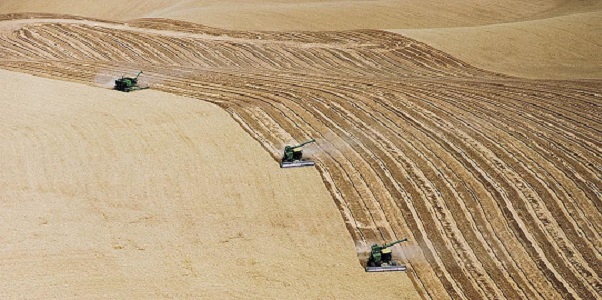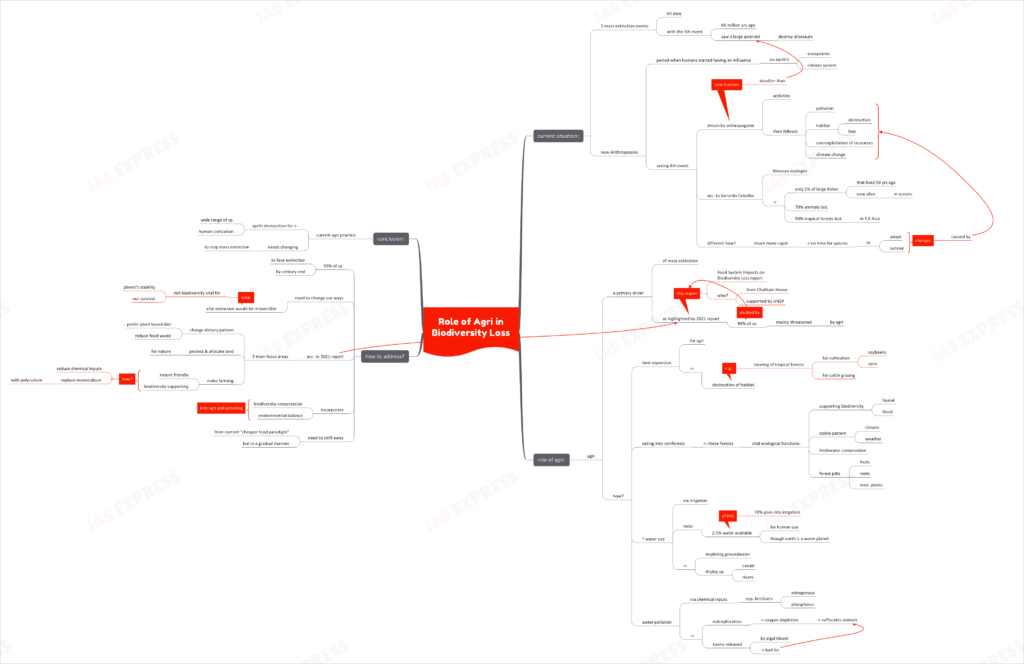Biodiversity Loss – Role of Agriculture

Recently, American author and journalist Scott Cameron Pele presented a report on the 6th mass extinction. One key highlight of this report is that it places agriculture at the centre of all anthropogenic activities contributing to this ongoing loss of biodiversity.

What is the current situation?
- So far, there have been 5 major mass extinction events that wiped out some of the species forever.
- The 5th event took place 66 million years ago, when a massive asteroid sent the dinosaurs into extinction.
- The current period, which started when humans started having a considerable influence on the earth’s ecosystems and climate system, is referred to as the Anthropocene.
- Now, the 6th extinction event is being driven by anthropogenic activities and their fallouts like pollution, habitat destruction and loss, resource over-exploitation and climate change.
- According to Mexican ecologist Gerardo Ceballos,
- A mere 2% of the large fishes that inhabited the oceans some 50 years ago are alive today.
- 70% of all animals are now lost.
- Since 2000, Southeast Asia lost 90% of its tropical forests.
- The consequences of human activities are so significant that humankind is emerging as a deadlier factor than the asteroid that annihilated dinosaurs.
- A notable point of difference between the previous 5 extinction events and the current one is that, while the former took place over millions of years, the latter is happening over mere decades.
- The rapid nature of this extinction event means that many species won’t have enough time to adapt to and overcome the ecosystem-level changes triggered by our actions.
What is the role of agriculture?
- Agriculture is one of the primary drivers of the ongoing mass extinction. This fact was also highlighted by the 2021 Food System Impacts on Biodiversity Loss report (from Chatham House and supported by UNEP).
- 86% of the species (covered by the report) are primarily threatened by agricultural activities.
- The expansion of land under agriculture means destruction of wildlife habitat. For instance, large swathes of tropical rainforests are being cleared to make way for cultivation of soybean and corn or for cattle grazing.
- Agricultural activities are also eating into the life-giving rainforests. These forests are responsible for a number of vital ecosystem functions:
- Supporting rich faunal and floral biodiversity
- Stable climate and weather pattern
- Freshwater conservation
- Steady supply of valuable forest produce like fruits, roots, medicinal plants, etc.
- Though earth is a water planet, a mere 2.5% of the water is actually available for human consumption (drinking, domestic purposes, etc.). Even of this small fraction, 70% is used for irrigation, as the modern agricultural systems depend on highly water intensive food crops.
- This water intensive approach of modern agriculture are increasing the pressure on groundwater resources. In several cases, rivers and canals have dried up.
- Another way in which agriculture is harming biodiversity is through water pollution.
- Chemical inputs, especially nitrogenous and phosphorus fertilizers, are accumulating in water bodies and triggering eutrophication.
- Eutrophication reduces the dissolved oxygen content of the water, thus suffocating aquatic organisms inhabiting the water body.
- Apart from this, algal blooms can release toxins into the aquatic environment, making it unfavourable for fishes and other organisms.
How can this be addressed?
- Scientists expect some 50% of all the species to face extinction by the end of this century.
- Without changing our ways, this extinction would become irreversible. A rich biodiversity is vital for the planet’s ecological stability, and consequently, our survival.
- The 2021 report called for urgent reformation of our food systems, by focusing on 3 main areas:
- Changing the dietary pattern
- Preferring a more plant-based diet
- Reduction of global food wastage
- Protecting and allocating land for nature
- Nature-friendly and biodiversity-supporting farming practices
- Limiting use of chemical inputs
- Replacing monoculture with polyculture practices
- Changing the dietary pattern
- Apart from this, it is necessary to incorporate biodiversity conservation and environmental balance into agricultural policymaking.
- It is vital to shift away from the current “cheaper food paradigm”, but this must be done in a gradual manner.
Conclusion:
The way agriculture is being practiced now is writing the story destruction, not only of a wide range of species, but also of human civilization itself. It is imperative that we change the way we grow our food if we are to stop the runaway train of mass extinction.
Practice Question for Mains:
What is the role of agriculture in the 6th mass extinction? What can be done to address this? (250 words)
If you like this post, please share your feedback in the comments section below so that we will upload more posts like this.

